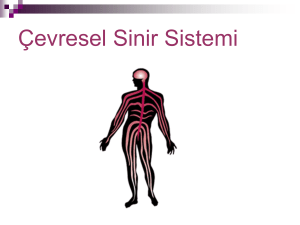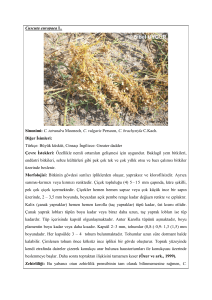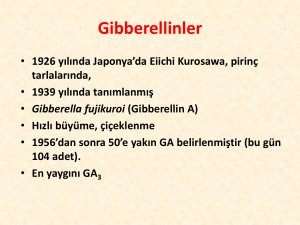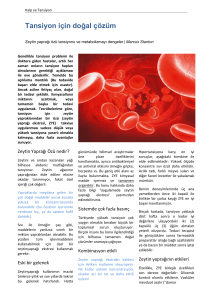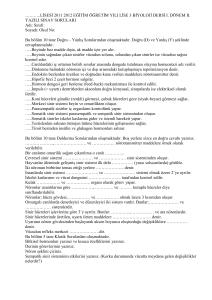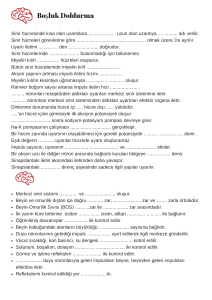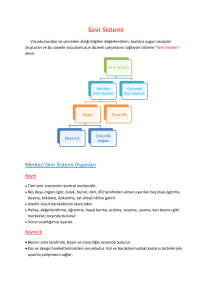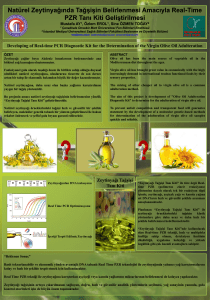proje kesın raporu yazımında
advertisement
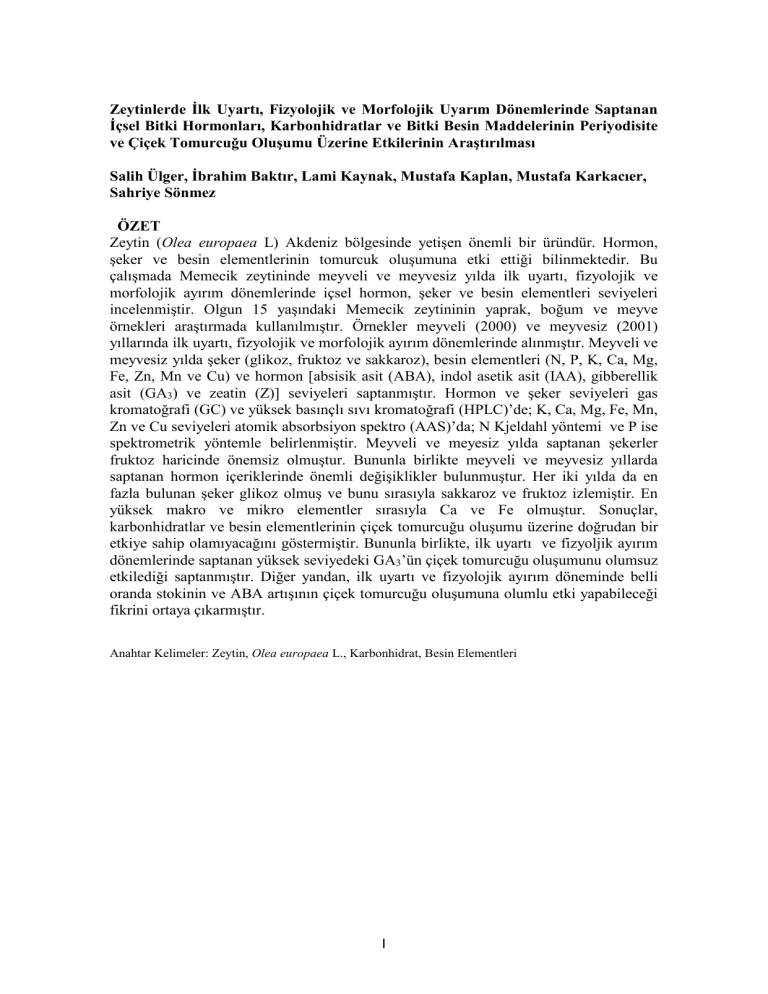
Zeytinlerde İlk Uyartı, Fizyolojik ve Morfolojik Uyarım Dönemlerinde Saptanan İçsel Bitki Hormonları, Karbonhidratlar ve Bitki Besin Maddelerinin Periyodisite ve Çiçek Tomurcuğu Oluşumu Üzerine Etkilerinin Araştırılması Salih Ülger, İbrahim Baktır, Lami Kaynak, Mustafa Kaplan, Mustafa Karkacıer, Sahriye Sönmez ÖZET Zeytin (Olea europaea L) Akdeniz bölgesinde yetişen önemli bir üründür. Hormon, şeker ve besin elementlerinin tomurcuk oluşumuna etki ettiği bilinmektedir. Bu çalışmada Memecik zeytininde meyveli ve meyvesiz yılda ilk uyartı, fizyolojik ve morfolojik ayırım dönemlerinde içsel hormon, şeker ve besin elementleri seviyeleri incelenmiştir. Olgun 15 yaşındaki Memecik zeytininin yaprak, boğum ve meyve örnekleri araştırmada kullanılmıştır. Örnekler meyveli (2000) ve meyvesiz (2001) yıllarında ilk uyartı, fizyolojik ve morfolojik ayırım dönemlerinde alınmıştır. Meyveli ve meyvesiz yılda şeker (glikoz, fruktoz ve sakkaroz), besin elementleri (N, P, K, Ca, Mg, Fe, Zn, Mn ve Cu) ve hormon [absisik asit (ABA), indol asetik asit (IAA), gibberellik asit (GA3) ve zeatin (Z)] seviyeleri saptanmıştır. Hormon ve şeker seviyeleri gas kromatoğrafi (GC) ve yüksek basınçlı sıvı kromatoğrafi (HPLC)’de; K, Ca, Mg, Fe, Mn, Zn ve Cu seviyeleri atomik absorbsiyon spektro (AAS)’da; N Kjeldahl yöntemi ve P ise spektrometrik yöntemle belirlenmiştir. Meyveli ve meyesiz yılda saptanan şekerler fruktoz haricinde önemsiz olmuştur. Bununla birlikte meyveli ve meyvesiz yıllarda saptanan hormon içeriklerinde önemli değişiklikler bulunmuştur. Her iki yılda da en fazla bulunan şeker glikoz olmuş ve bunu sırasıyla sakkaroz ve fruktoz izlemiştir. En yüksek makro ve mikro elementler sırasıyla Ca ve Fe olmuştur. Sonuçlar, karbonhidratlar ve besin elementlerinin çiçek tomurcuğu oluşumu üzerine doğrudan bir etkiye sahip olamıyacağını göstermiştir. Bununla birlikte, ilk uyartı ve fizyoljik ayırım dönemlerinde saptanan yüksek seviyedeki GA3’ün çiçek tomurcuğu oluşumunu olumsuz etkilediği saptanmıştır. Diğer yandan, ilk uyartı ve fizyolojik ayırım döneminde belli oranda stokinin ve ABA artışının çiçek tomurcuğu oluşumuna olumlu etki yapabileceği fikrini ortaya çıkarmıştır. Anahtar Kelimeler: Zeytin, Olea europaea L., Karbonhidrat, Besin Elementleri I Determination of The Effects of Endogenous Plant Hormones, Carbohydrates and Plant Nutrients in the Periods of Induction, Initiation and Differentiation on Alternate-bearing and Flower Bud Formation in Olives Salih Ülger, İbrahim Baktır, Lami Kaynak, Mustafa Kaplan, Mustafa Karkacıer, Sahriye Sönmez ABSTRACT Olive (Olea europaea L) is one of the most important crop plants grown in the Mediterranean region. Changing levels of hormones, sugars and nutrients are thought to influence flower bud formation. The objective of this study was to evaluate the changes in endogenous sugar, mineral nutrition and hormone levels in leaf, node and fruit samples of the olive cultivar ‘Memecik’ during the induction, initiation and differentiation periods in on and off years. Leaf, node, and fruit samples of mature 15year old ‘Memecik’ olive cultivar were used. The samples were taken during the induction, initiation and differentiation periods of olive in on (2000) and off (2001) years. Sugar (glucose, fructose and sucrose), mineral nutrient (N, P, K, Ca, Mg, Fe, Zn, Mn and Cu) and hormone [abscisic acid (ABA), indole acetic acid (IAA), gibberellic acid (GA3, GA4), and zeatin (Z)] levels were determined in on and off years. Hormone and sugar levels were measured by gas chromatography (GC) and high performance liquid chromatography (HPLC). K, Ca, Mg, Fe, Mn, Zn and Cu were quantified by an atomic absorption spectrophotometry (AAS). Nitrogen was determined by the Kjeldahl procedure, and P a Spectrophotometric method. The differences in all sugar levels with the exception of fructose were not significant in on and off years. Hormone levels, however, were significantly different in on and off years. The highest level of sugar was that of glucose in both years, followed by sucrose and fructose, respectively. The highest macro and micro element concentrations were found to be Ca and Fe, respectively. Thus, the results suggest that carbohydrates and mineral nutrients may not have a direct effect on flower initiation. However, high GA3 level exhibited an inhibitory effect on floral formation during the induction and initiation periods. On the other hand, the results indicate that GA4, ABA and certain cytokinin levels may have a positive effect on flower formation in olive during the induction and initiation periods. Key words: Olive, Olea europaea L., Hormones, Carbohydrates, Mineral Nutrients II
